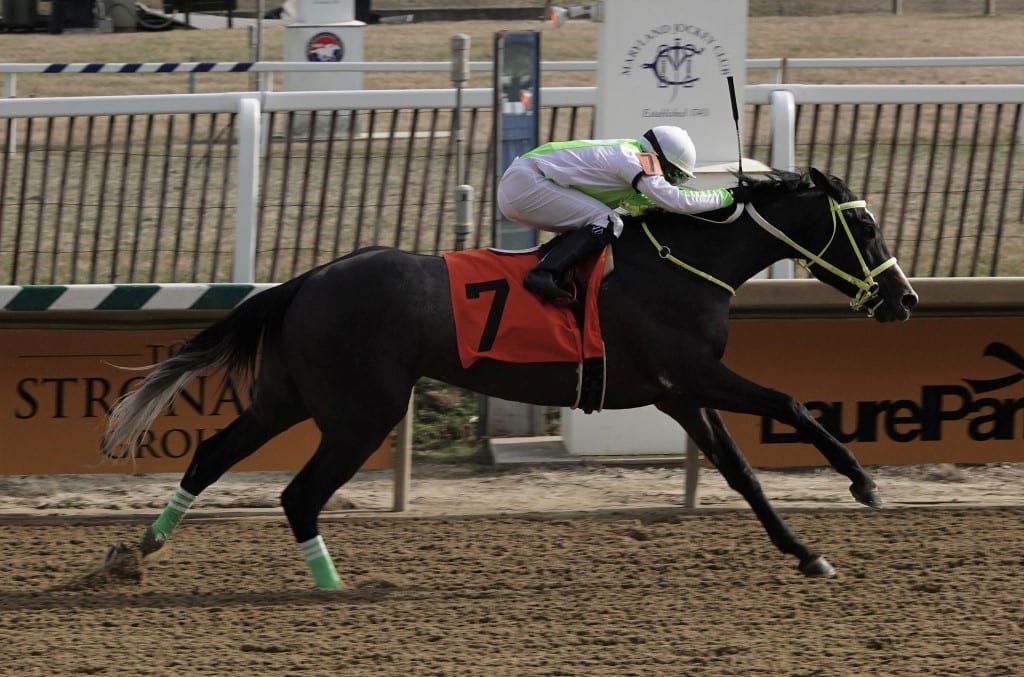
A nearly evenly split Maryland Racing Commission cleared the way Thursday for Lasix-free two-year-old racing in the Free State.
But it wasn’t enthusiastic about the decision, and Commissioner Ernie Greco may have spoken for the body as a whole when asked whether he approved the proposal: “I guess so,” he said after a pause.
The Commission’s vote will enable Maryland to hold two-year-old races without permitting the otherwise legal diuretic furosemide, commonly known as Lasix.
To enact the ban, the Commission simultaneously adopted an emergency regulation prohibiting the administration of Lasix to two-year-olds within 48 hours of a race in which they are scheduled to run. The earliest the regulation can take effect is July 30.
That provision, along with several others, is embedded in an agreement reached earlier this week between the Maryland Jockey Club, its parent company The Stronach Group, and the Maryland Thoroughbred Horsemen’s Association (MTHA).
The vote to approve the agreement and adopt the regulation was 5-2 with Clarissa Coughlin and Konrad Wayson voting no. Two other Commissioners who seemed more inclined towards the “no” camp, Tom Bowman and Tom Winebrener, abstained. Voting yes were chairman Michael Algeo, Greco, Tammy Lafferty, David Hayden, and Emmitt Davitt.
The agreement provides The Stronach Group with what it had sought at a contentious meeting last month: bans on Lasix in baby races and, starting in 2021, in graded stakes. Prior to the Covid-19 pandemic, Maryland had been scheduled to host 11 graded stakes this year, and of course, Pimlico hosts the Grade 1 Preakness Stakes.
The agreement, pitched as a “pilot project,” extends through 2023.
Though The Stronach Group got what it wanted – and the company’s chief executive of racing Craig Fravel thanked the Commission “for their cooperation and their understanding” – the anti-Lasix provisions didn’t come cheap.
The company also agreed to donate $1 million to Maryland’s Beyond the Wire Thoroughbred aftercare program, as well as to match owners’ contributions to the program. Those moneys will come in the form of four annual payments of $250,000. The Maryland Jockey Club also agreed that, when it is hosting live racing, it will conduct a minimum of three days per week – it’s currently racing just two days each week – and that it will underwrite any overpayments of the purse account.
The agreement also includes a vaguely worded provision calling on the signatories to “discuss in good faith” a study that would involve post-race scoping of horses to obtain “relevant data.” It does not include a funding mechanism, assignment of responsibility, or even “study research parameters and objectives,” all of which are to be part of the discussions.
“This agreement and our ultimate decision I see as something that is required to advance our industry,” said Algeo, who earlier had likened the Commission’s role to that of a doctor, as in, “Do no harm.”
But Bowman, a veterinarian by trade who abstained from voting, said he saw the study provision as essentially window dressing.
“The proposal to have a study sounds good,” he said. “Until you ask yourself who does it and what kind of data you want.”
Bowman suggested that provision should be beefed up and that the aftercare donation from the MJC be reprogrammed to support the study.
He also expressed his frustration with the process that led the Commission to this point. In June, The Stronach Group had proposed, with about a week’s notice, to begin carding two-year-old races without permitting Lasix. But it had bypassed getting agreement from the state’s horsemen or even smoothing the way with the Commission.
Since the company also refused to card two-year-old races with Lasix, that left the state’s horsemen high and dry, with a reported 100 ready-to-run babies on the Laurel backside but no local races for them. No baby races have been run locally at this point — some three months after the typical beginning of two-year-old racing and six weeks after the state had resumed racing following a Coronavirus-related shutdown.
“An example of how not to operate and how not to behave,” Bowman called it.
Commission Konrad Wayson, who voted against the emergency reg, agreed with Bowman.
“The only way this is emergency legislation is the Maryland Jockey Club made it emergency legislation,” Wayson said. “There’s a process and a procedure to go through to change the code, and that’s what needs to be done on this one.”
Horsemen had previously expressed their desire for a regional solution to the Lasix issue. The Mid-Atlantic has largely moved in lockstep on medication issues in recent years, and such cooperation is desirable in a compact area with a large number of tracks.
They did not obtain that regionwide consensus, however. Because of the rules surrounding the use of Lasix, that likely means that Maryland-based two-year-olds will either remain exclusively in Maryland or race exclusively in jurisdictions where the medication is permitted.
Two trainers, Katy Voss and Jerry Robb, expressed concern about the possibility of the Maryland rule thus leaving trainers in a tight spot.
“It’s going to put a hurting on a lot of people,” said Robb, some of whose two-year-olds have already raced at Delaware Park.
The agreement crafted by the parties did not include the Maryland Horse Breeders Association, and MHBA president Michael Harrison, a veterinarian, said he was “disappointed that the Horse Breeders were not involved in final negotiations.”
It also did not include the Maryland State Fair and Agricultural Society, which operates the seven-day Timonium meeting. But since the Lasix rule is being adopted as a regulation, it will apply to that meet and to all other Thoroughbred venues in the state.
The Maryland Jockey Club indicated via text that it would start writing baby races as soon as it had secured Commission permission. The current condition book, which extends through the end of the current meet August 22, does not include any two-year-old races.
LATEST NEWS













